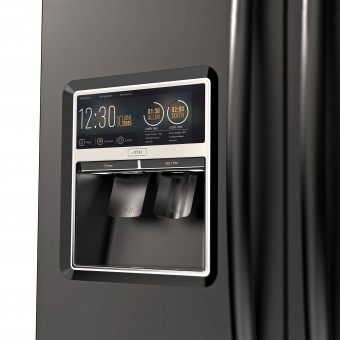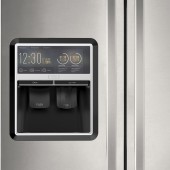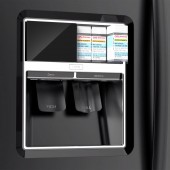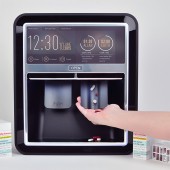DESIGN NAME:
PharmAssist
PRIMARY FUNCTION:
Medication Management Device
INSPIRATION:
Aging in place is becoming an increasingly popular trend in the United States. Many elderly patients now choose to live at home rather than transition to a nursing home or assisted care facility. Though there are many benefits to staying in the same environment, there are also risks. After conducting interviews at Phoenix-based nursing homes and within Arizona State University’s geriatric nursing program, it became clear that one of the most prominent risks is the mismanagement of medication.
UNIQUE PROPERTIES / PROJECT DESCRIPTION:
PharmAssist is an in-home, low-profile, automated medication management device designed to fit in a residential refrigerator in place of a standard water and ice dispensing unit. This system is designed primarily for elderly patients, and emits visual and audio alerts, dispenses medications at pre-programmed times throughout the day, and automatically sends digital refill requests to the patient’s pharmacy.
OPERATION / FLOW / INTERACTION:
After the initial setup, the customer will receive all prescriptions in a PharmAssist compatible bottle that is then inserted into the device. PharmAssist will read information off the bottle's NFC chip to emit visual and audio alerts, dispense the user’s medications at pre-programmed times through the left-side chute, and automatically send refill requests to the patient’s pharmacy. This will decrease the amount of human error for elderly patients who choose to administer their own medication.
PROJECT DURATION AND LOCATION:
This project was completed at Arizona State University in U.S. from September 2015 to December 2015. PharmAssist was also exhibited at by Model Solution company who fabricated the appearance model in their 2016 showcase at the International IDSA Conference in Detroit in the U.S.
FITS BEST INTO CATEGORY:
Home Appliances Design
|
PRODUCTION / REALIZATION TECHNOLOGY:
Interviews with nurses and nursing professors indicated that most existing medication management devices are set up in the kitchen. While sketching and building foam core prototypes, we decided to integrate the device into the front face of the refrigerator to give it a lower-profile and tie it in more seamlessly with the health and wellness hub of the home. After settling in this direction, we created a series of CAD iterations and an appearance model with a professonal prototyping company.
SPECIFICATIONS / TECHNICAL PROPERTIES:
Height 374mm x Width 304mm x Depth 98mm
TAGS:
Medication, Medication Management, Elderly Care, Geriatric Care, Smart Home, Connected
RESEARCH ABSTRACT:
Interviews became the primary type of research for PharmAssist. The intent was to establish the most common risks for aging in place, and collect more information about existing solutions to make this practice safer and more comfortable. Interview questions were prepared beforehand, and all discussions were filmed or voice recorded for reference. Formal interviews were conducted with Geriatric Nursing Professors from Arizona State University’s nursing school, as well as with employees at an assisted living facility in Phoenix. Informal interviews with contacts that had assisted older relatives with in-home care were also taken into account.
After conducting interviews and mapping out all the information collected, three major risks appeared at the forefront – falls, loneliness, and medication mismanagement. Once interviews became more focused, issues with current medication management devices came to light, such as the potential to demean the user, be difficult to operate, and not work in coordination with pharmacies. Though there are many challenges to aging in place, research suggested that improving these devices could assist elderly people with living safely and more comfortably in the environment they call home.
CHALLENGE:
The primary challenge was designing a device that would encourage rather than demean the user when on display in their home. Several of the geriatric nursing professors at ASU explained many elderly patients hesitate to use existing medication management devices for fear that they will signal a lack of independence to guests entering the home. This influenced the decision to create a functional, yet low profile solution that fits seamlessly into a modern user’s home.
ADDED DATE:
2019-09-23 17:53:24
TEAM MEMBERS (2) :
Designer: Muriel Shields and Designer: Dosun Shin
IMAGE CREDITS:
Main Image, Image #1, 2, 3, 4: Muriel Shields
Video Credits: Muriel Shields
|









